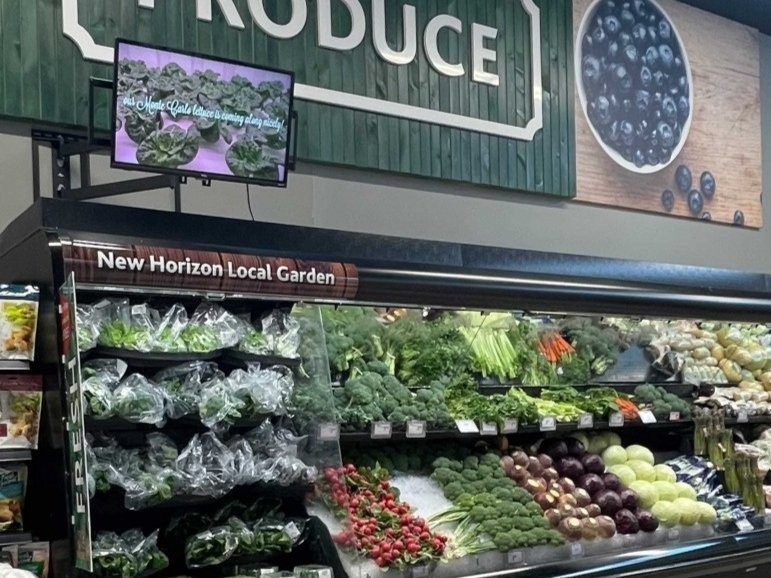Vertically Farmed Produce Marketability: Is it good enough for store shelves?
Growcer’s Research and Development team is currently conducting lettuce trials to see what impact certain conditions have on lettuce to ensure we’re optimizing production.
In addition to recording yield and size data, we also collect “marketability” data.
What do we mean by that? What makes one lettuce head more marketable than another?
The R&D team began with a broad definition and identified the following criteria to give each plant a marketability score.
Decision criteria
Tip burn
Bolting
Weight
Uniformity
Packaging presence
Each criteria impacts marketability positively or negatively.
Tip burn
Tip burn on lettuce looks like crumpled, yellow (“burned”) edges on the leaf margins of the lettuce. It's a no-brainer that tip burn is unsightly for customers and therefore negatively impacts the marketability of your lettuce.
However, Growcer’s vertical airflow system significantly limits instances of tip burn by improving air circulation and reducing microclimates under canopies.
Therefore, because instances of tip burn are rare - it didn’t impact marketability scores. In other words, ceremoniously adding “zero tip burn” was just extra work.
Bolting
Bolting is when a plant begins to allocate more of its energy towards flower and seed production, rather than leaf growth. Bolted plants have smaller leaves and a more bitter taste. Small and bitter don’t necessarily scream “marketability.”
For lettuce, bolting was so rare it also did not make a difference to marketability scores.
Understand retailer requirements for volume and weight by talking with them directly or visiting their website.

However, if we were investigating spinach, this criteria could’ve been more statistically significant.
Weight
If you plan to sell to commercial distributors (grocery stores, institutions, restaurants), you want your product to meet their requirements.
The target market size for a head of lettuce is around 10cm to 11cm with a weight of 80g to 90g+ per head.
So measuring weight directly relates to marketability. Anything that falls below the target market size is considered unmarketable. Simple math.
Uniformity
No snowflake is the same and that’s beautiful. Unfortunately, customers do not feel the same way when it comes to their produce.
A shelf filled with differently-sized produce does not satisfy customers who have grown accustomed to “pretty produce.”
(Until it becomes more budget-friendly to do so, and we’re seeing Canadians increasingly turning to ‘imperfect’ food as grocery prices soar.)
So what does uniformity look like? Our R&D team defined uniformity as “no difference larger than 5cm” in width to achieve homogeneity.
Basically, are all the lettuce heads relatively the same size?
Packaging presence
Never judge a book by its cover - but if that cover is getting in the way of marketability, then yes, do.
Packaging presence comes in two parts: what packaging material are you picking, and how does that specific plant look within it?
For example, what’s the best way to package a round head of Rex Butterhead lettuce? Is it a plastic sleeve? A clamshell?
How do we quantify how “good” something looks in packaging? Consumers like to see “full” packages (when was the last time you wanted to buy a bag of chips that was 50% air?) To measure that we decided to use a fullness scale of 1 to 4.
1 - Indicates a tight fit (lettuce is squeezed and damaged in packaging)
2 - Indicates an ideal fit (tight with no movement)
3 - Indicates a loose fit (tight with little movement)
4 - Indicates a too loose fit (lettuce heads moves too much in packaging)
If a batch gets too many scores in the extremes (1 or 4), then it’s considered unmarketable.
It’s important to note that not all packaging is the same. With detailed width and height measurements, it might be easier to find packaging tailored to specific cultivars so that the fit is always “just right.”

A side by side comparison between a rex butterhead with a score of 2 and 4.
Conclusion
In summary, recording the weight, uniformity, and packaging presence of a harvest were some of the ways we assessed its “marketability score.”
While it’s nice to always optimize yields, we’re also in the business of helping growers in our network sell their produce, so it’s important to always factor in marketability alongside production.
Vertical Farming Comparison Guide
Download to learn how you can discern facts from fiction in the vertical farming world

This guide compares and contrasts key aspects of vertical farms, helping you make decisions about your own business, understand more as a student or educator, and ultimately dispel any myths and legends.
Download the guide to better understand:
DIY vs. Turn-Key Solutions
All About Yields
Horizontal vs. Vertical Stacking
DWC vs. NFT Hydroponic Setups
Choosing Your Provider

